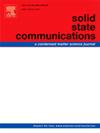探索Nd0.5Ba0.5FeO3的多功能性:结构、电子、磁性和光学性质的计算研究
IF 2.1
4区 物理与天体物理
Q3 PHYSICS, CONDENSED MATTER
引用次数: 0
摘要
对具有良好的电子、磁性和光学特性的多功能材料的需求不断增长,要求探索创新的钙钛矿结构,以实现先进的技术应用。在这项研究中,我们使用密度泛函理论(DFT)和Hubbard现场项(DFT + U)进行校正,深入分析了Nd0.5Ba0.5FeO3 (NBFO)的结构、电子、磁性和光学性质。计算使用Quantum Espresso软件套件进行。带结构分析表明,氧轨道和铁轨道之间存在明显的杂化,有利于C-AFM磁有序结构作为能量最稳定的构型。光学性质突出了紫外-可见(UV)范围内的吸收,证明了在光电子学和自旋电子学中的可行应用。最后,系统地探讨了介电常数、消光系数和光电导率。这些发现使NBFO成为高频电子、光电子器件和自旋电子学等先进技术应用的通用材料。本文章由计算机程序翻译,如有差异,请以英文原文为准。
Exploring the Multifunctionality of Nd0.5Ba0.5FeO3: A computational study on structural, electronic, magnetic, and optical properties
The growing demand for multifunctional materials with having good electronic, magnetic, and optical features require a exploration of innovative perovskite structures for advanced technological applications. In this study, we in-depth analyse of the structural, electronic, magnetic, and optical properties of Nd0.5Ba0.5FeO3 (NBFO), a cubic perovskite material, using Density Functional Theory (DFT) corrected with a Hubbard on-site term (DFT + U). The calculations were performed using the Quantum Espresso software suite. The band structure analysis reveals metallic behavior with significant hybridization between oxygen and iron orbitals, favoring a C-AFM magnetic ordering as the most energetically stable configuration. The optical properties highlight absorption in the ultraviolet–visible (UV) range, demonstrating feasible applications in optoelectronics and spintronics. Finally, dielectric constants, extinction coefficients, and optical conductivity, were systematically explored. These findings position NBFO as a versatile material for advanced technological applications in high-frequency electronics, optoelectronic devices, and spintronics.
求助全文
通过发布文献求助,成功后即可免费获取论文全文。
去求助
来源期刊

Solid State Communications
物理-物理:凝聚态物理
CiteScore
3.40
自引率
4.80%
发文量
287
审稿时长
51 days
期刊介绍:
Solid State Communications is an international medium for the publication of short communications and original research articles on significant developments in condensed matter science, giving scientists immediate access to important, recently completed work. The journal publishes original experimental and theoretical research on the physical and chemical properties of solids and other condensed systems and also on their preparation. The submission of manuscripts reporting research on the basic physics of materials science and devices, as well as of state-of-the-art microstructures and nanostructures, is encouraged.
A coherent quantitative treatment emphasizing new physics is expected rather than a simple accumulation of experimental data. Consistent with these aims, the short communications should be kept concise and short, usually not longer than six printed pages. The number of figures and tables should also be kept to a minimum. Solid State Communications now also welcomes original research articles without length restrictions.
The Fast-Track section of Solid State Communications is the venue for very rapid publication of short communications on significant developments in condensed matter science. The goal is to offer the broad condensed matter community quick and immediate access to publish recently completed papers in research areas that are rapidly evolving and in which there are developments with great potential impact.
 求助内容:
求助内容: 应助结果提醒方式:
应助结果提醒方式:


